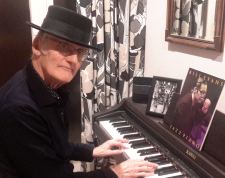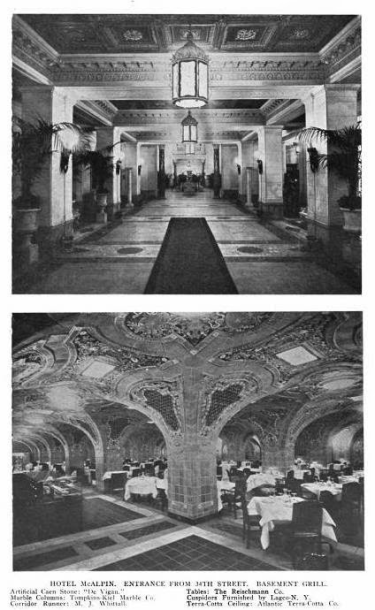.
.
(from Beyond the Gilded Age)
The 34th Street entrance (top) and the Basement Grill in New York’s McAlpin Hotel
.
.
___
.
.
The Sybil on 34th Street
by Ray Robinson
.
…..My old Classics teacher was a very likeable fellow, ageing, benign, not wanting to retire yet, not just yet. So four of us were persuaded to take up Ancient Greek to accompany our studies in Latin. Nobody else wanted to do it, but somebody had to keep the old codger in a job. I had to give up Geography to find time for it but I didn’t think that was a subject anyway, so I didn’t mind. Four to one. The pupil to teacher ratio was better than at Eton College.
…..You might be forgiven for wondering what a lad from the Shore Road in Belfast was thinking about, studying Classics. It may seem counter-intuitive, but Shore Road people can be more snobbish than you would imagine. Social nuances along our road were powerful. There’s a doctoral thesis in there somewhere – “Social Stratification in a Working Class Area of Belfast.”
…..I hold to the belief that teachers, in some way, don’t really teach a subject, they teach themselves. And Wee Jimmy, as we called him behind his back, was intent on keeping us interested. When the Latin and Greek got too much, he would regale us with tales of the Ancient World. My favourite was Sybil. Sybil lived in a cave and gave advice. Important men, usually generals or politicians, would go to consult Sybil before making some big decision. Money would change hands; there was no free advice. Incense would be burned; there would be lots of hypnotic smoke and Sybil would go into a trance. Jimmy never suggested the possibility of herbs being smoked; we were too young and innocent to think of such things. It was a long time ago.
…..Anyway, Sybil definitely had to inhale. The question would be put to her and she would give an answer. Very often the answer came out in the form of a riddle. Sybil was in a bit of a state due to her being intoxicated so she couldn’t really be expected to give a definitive answer. You needed to interpret what she said, so you probably ended up answering your own question. That was the bit I liked.
…..At this point I need to explain something seemingly unconnected to ancient mythology. It’s to do with my own personal history. There were no books in our house. Literally. Dad read the Belfast Telegraph, Mum read Woman’s Own. A literate household, but no books. I had an American cousin, Marianne. Her dad had been here in Ireland in the forties before going off bravely to fight Hitler. It’s just a fact that there were Americans in my grandmother’s house for a while before I was born. Everybody in the family could play “In The Mood” very badly. But that’s a whole other story.
…..Marianne’s dad had sent her a copy of Miracle on 34th Street, a novelization of a film. She let me have it when she’d finished it. It became the first book I read cover-to-cover for pleasure as opposed to a school book. You know the story, everybody’s seen it at Christmas. Macy’s Santa is the real Santa. It’s a heart-warming story. Gimbel’s is in there too. I didn’t know it at the time I was reading the book but the film was released for Xmas 1947, which was the year I was born, five days before Christmas. 34th Street was a part of my DNA.
…..In the early seventies, Marianne’s father vouched for me, signing the paperwork which permitted me to be given a student visa, allowing me to work and stay for a while in America. I’d only been in New York a couple of days and things weren’t going well. I had a job in a gas station working nights in Jamaica, Queen’s, but it was in a difficult part of town for me – there were threats, and I needed to get work somewhere else. Luckily, I met an Irishman in a bar and he offered to help. A few days later, respectably sober and with my new best pal to recommend me, I was given a job as a night cleaner in the McAlpin Hotel on Broadway where it cuts across between 5th and 6th Avenues at 34th Street. On the other side of Broadway, through the steam rising up from metal grilles in the tarmac, I could see the rival stores of my fable, Macy’s and Gimbel’s. I was living the myth.
…..The McAlpin was a New York landmark. The biggest hotel in the world when built, it offered a place of refuge for women. The city was a dangerous place, particularly for women arriving alone. They were likely to be harassed or waylaid by bad people. The McAlpin had a women’s reception area on the third floor, well away from the street and that whole floor was reserved for women only.
…..At street level, the hotel hosted a cocktail bar, open to all-comers. Its décor owed a lot to the Spanish artist Joan Miro. The table-tops had that characteristic blobby shape, like an artist’s palette. The style had been fashionable years before. It was dark in there, profoundly so. If customers dropped coins on the floor, they often didn’t bother looking, there wasn’t much point. The place was small, intimate, but big enough to house a baby grand in the corner. The top board was never lifted; there was a cut-glass bowl resting on it. The place was filled with smoke, so much smoke.
…..There were bar stools ranged around the piano and a brass foot rail was screwed onto its legs; customers could get close up to the lady who sat there playing gently and breathing her wisdom into a microphone. The place was scarcely big enough to warrant a microphone but this allowed the singer to be more conversational than vocal, more Billie than Ella. That way, she was well able to hypnotize her audience.
…..This Sybil was of indeterminate age, it was too dark to tell. Her hair was straight and blonde and largely covered her face. It might even have been real, who could tell? What was more important was that her chording was sublime and that she was familiar with the wisdom contained in any song you might request. A customer, male or female but more often male, would place a bank-note in the jar and name his choice. It might have been “I Can’t Get Started,” “I Didn’t Know About You,” “The Nearness of You,” or “I Get Along Without You Very Well.” Her songs were seldom up-tempo, nearly always ballads, heartbreak territory.
…..Sybil had moved on from wars and politics to affairs of the heart. In delivering her version of the request, she was confirming what the supplicant pretty well knew already, just as in Classical times. I only got to hear her once; her working hours and mine coincided. At the end of her shift she would empty the glass jar of money and drift home. Hours later I would come in with my workmates to clean the place and scavenge for change, a poor acolyte to her superior calling.
…..It was only years later that I realized how important Sybil was to me, how big an impression she had made. I have tried to find out her name or something about her, but she worked in the days before Wikipedia and Google. I have asked American musicians I know but it was too long ago. Someone out there should be able to tell me a little about her. When we go to the States I try to find a modern equivalent, a younger Sybil, but to no avail. It would be so good, just to sit at her piano and hear her answer profound questions about love and longing and loss. And I’m sure Wee Jimmy would have loved to have heard her as well.
.
.
___
.
.

Ray Robinson was born in Belfast, Northern Ireland, in 1947 and grew up in the city. He has published a teenage novel called High School Confidential about his time there. He studied at Trinity College, Dublin before returning to the North to follow a career in teaching and librarianship. From his earliest years he has been passionate about jazz piano. He plays every week in his local Library. Wherever he travels, be it New York, Philadelphia, Cork, Venice, Paris, Edinburgh, he likes to discover the places where music is best performed.
.
.
___
.
.
Click here to read “A Quick Kill: A Final Episode Among Brothers” – a true story by J.S. Kierland
Click here to read a true jazz story, “A remembrance of jazz afficionado Al Summ”
Click here for information about how to submit your own “true jazz story”
.
Click here to learn how to subscribe to the Jerry Jazz Musician newsletter
.
.
.

































